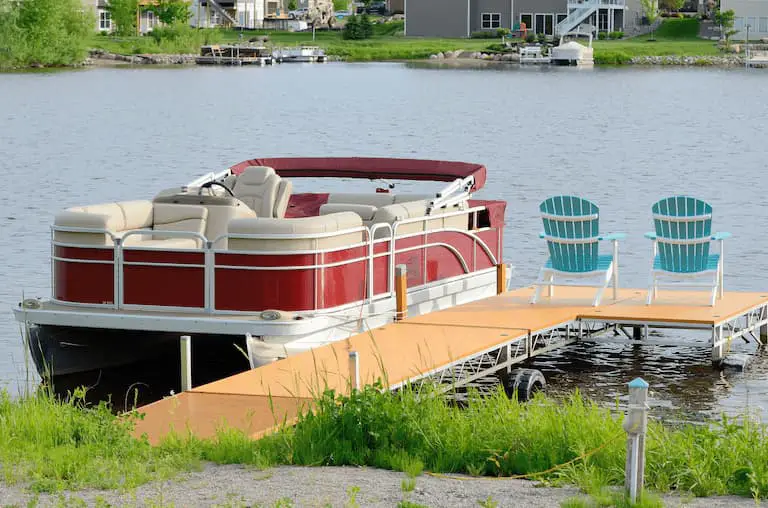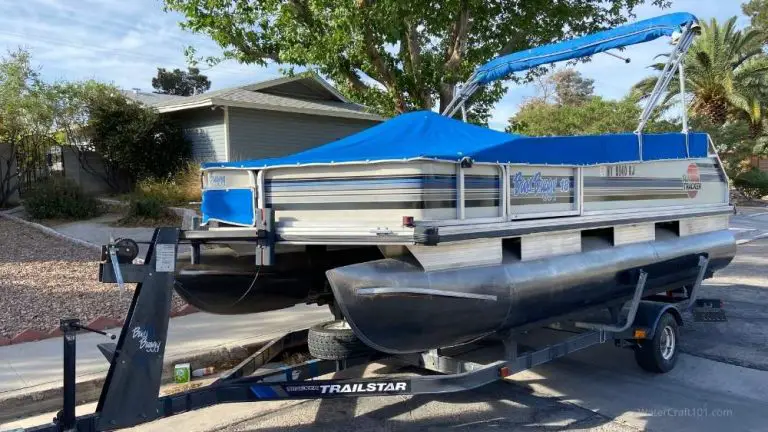How To Safely Dock a Pontoon Boat (11 Pro Tips)
Cruising on a pontoon boat is fun, but they often present challenges when you need to dock them. So, how can you safely pull up and dock a pontoon boat?
Here are 11 tips for docking a pontoon boat:
- Be comfortable driving your pontoon.
- Prepare the pontoon for docking.
- Check the dock conditions.
- Put the pontoon in neutral and slow down.
- Put the pontoon in reverse as you approach the dock.
- Line up your dock approach.
- Time your swing.
- Have someone guide you in from the dock.
- Navigate into the dock.
- Tie your pontoon onto the dock.
- Shut the engine off.
I’ll explain each of these tips in more detail below.

1. Be Comfortable Driving Your Pontoon Boat
Docking a pontoon is no small feat and requires a lot of confidence and knowledge of the pontoon.
Before docking your pontoon for the first time, you need to be comfortable driving it and have a solid awareness of its size and how much throttle you need to give it in various wind and current conditions.
When docking a pontoon, you’ll need to put it in neutral and allow it to sail on its own momentum. You should practice doing this beforehand to understand how your boat moves in the water when it’s in neutral.
Before attempting your first docking, you should also practice turning the pontoon and navigating it into various positions.
2. Prepare the Pontoon for Docking
If you want to dock your pontoon with minimal fuss, it’s essential to prepare for it in advance. Make sure that you’ve your dock lines and fenders (aka bumpers) handy on both sides of the pontoon.
The dock lines secure the pontoon to the dock, while the fenders protect the boat if it bumps against the dock.
If you’ve other crew members onboard your pontoon, delegate crucial tasks to them, such as handling the dock lines, attaching the fenders, or preparing them to jump off the pontoon to help guide you up to the dock.

3. Check the Dock Conditions As You Approach With Your Pontoon
As soon as you can see the dock in your line of sight, start thinking about the best docking strategy. If you’ve never docked a pontoon before, you might consider sailing past the docking area and then pulling back to note any peculiarities and feel more confident.
It’s a good idea to consider the following before going ahead with your docking plan:
- What are the wind and current conditions like? When docking a pontoon, it’s usually easier to do it into the wind as you’ve got more control. Look out for any crosswinds as pontoons are sensitive to these. It’s also vital to check if there’s a strong current close to the dock, affecting how you dock your pontoon.
- How high is the dock? This will help you determine the best position for the fenders so that your pontoon doesn’t get damaged.
- On which side of the pontoon do you want to dock? Once you’ve decided which side you want to dock your pontoon on, you can start preparing for the fenders to be attached. Docking a pontoon on the same side as the captain’s wheel can make the process easier.
- Are there swimmers in the water? To prevent an accident, ensure that there are no swimmers, snorkelers, or water skiers ahead of your pontoon.
- Can you see the dock clearly? To navigate your pontoon safely to the dock, you need to see it clearly. Consider asking guests to sit down or stand up at the helm for enhanced visibility. Opening the boarding gate can also improve visibility.
- Are there other boats nearby? Other boats are potential obstacles, and it’s best to keep your distance to avoid a crash.
- Where will you tie the pontoon? Take note of the cleats’ location on the dock so that you know where you need to tie the pontoon. If there aren’t cleats, you’ll need to tie the pontoon to the pilings.
- How much space do you have? During busy times at the dock, space can be at a premium, leaving you with little room to maneuver and turn around if needed.
- What kind of dock is it? Is it a fixed or floating dock? Fixed docks are secured firmly in place while floating docks are attached to the land with no water anchors. Approaching a floating dock is typically easier as it gives the pontoon more leeway.
- Can you choose your docking space? If the marina is busy and you need to park next to another boat or pontoon, it’s easier to park alongside one that’s a similar or larger size as this reduces the chance of an accidental bump.
4. Put the Pontoon in Neutral and Slow Down as You Near Dock
When approaching the dock, consider a worst-case scenario where you’d hit the dock. Then adjust your speed according to how slowly you’d want to hit the dock (it’s normally slower than you think). If the worst happens and you accidentally hit the dock, approaching it slowly may cause minimal damage.

Slowly approaching the dock gives you more control over the pontoon. If there are any unexpected wind or current conditions, a slow approach gives you time to react.
As your pontoon enters the dock slip, there’s limited space and little room for error, another vital reason to slow down. However, if you make an error, it’s easier to correct it when you’re moving slowly.
Putting your pontoon in neutral slows it down further, allowing it to sail on its own momentum. If there’s very little wind and current, however, and you feel that the pontoon doesn’t have enough momentum, put it back into gear for a few seconds and then back into neutral. Repeat this process whenever necessary, but be careful not to give it too much power to propel it forward too fast.
When putting your pontoon in neutral, trimming up the outboard motor may be a good idea. As you approach the dock, the water will likely become shallower, and trimming the motor lifts the pontoon’s hull up to prevent damage. It also allows the engine to move if the pontoon accidentally runs aground.
Keep an eye on the propeller, though, as it needs to be immersed in the water to help you control the steering effectively. You can usually find the trim switch close to the pontoon’s rudder.
5. Put the Pontoon in Reverse As You Approach the Dock
When you’re close to the dock, put the pontoon in reverse so that you can navigate its bow into the dock first.
When you’re preparing to dock a pontoon, it’s best to keep it well-balanced without making any sudden movements. To help keep the pontoon well-balanced, safe and to distribute the weight evenly, consider asking your passengers to sit down until the pontoon has docked.

6. Line Up Your Dock Approach With Your Pontoon
Start lining up your approach when you’re ready to steer the pontoon into the dock.
If the current and the wind are behind you, you should come into the dock at a wide and gentle angle. You’ll need to approach the dock at a sharper angle if it’s against you, as this will give you more momentum to perfect the docking.
Once you’ve angled the pontoon correctly, start aiming for the dock’s center, and where you want to tie the pontoon onto the dock.
7. Time Your Swing
As you get close to the dock, start turning the pontoon to approach the slip at a 45° angle.
Just before you reach the dock, turn the steering wheel all the way and toward your docking side. Slide the pontoon into reverse and carefully proceed closer to the dock. This will swing the stern (rear end) of the boat towards the dock.
Putting your pontoon in reverse helps you retain control of it, make precise movements, and slows forward momentum.
Timing your swing into the dock is vital, and most experienced pontoon owners find that the best time to swing the wheel is when you’re about one pontoon length away.
Continue slowly and carefully guiding the stern of your pontoon into the dock until it’s parallel with the dock. Once parallel, you’ll turn the steering wheel back to straight. Keep your hand on the steering wheel to correct any wayward movements.
Put the pontoon into neutral again, and allow its momentum to drift it perfectly into place.
8. Have Someone Guide Your Pontoon In From the Dock
If you have an able crew member onboard your pontoon, having them guide you into the dock can help immensely.
When the pontoon is within striking distance of the dock, have the person jump out of the pontoon and guide you in from land.

9. Navigate The Pontoon Boat Into the Dock
Navigating into the dock is the trickiest part of pulling a pontoon up to a dock.
Remember that your docking position doesn’t need to be 100% perfect. As long as you’re in the slip, you’re fine, and if you want to make minor adjustments to your docking position later, it’ll be easy to do.
If you find navigating into the dock challenging and struggle to dock your pontoon with precision, you might consider investing in a fully retractable thruster system. This product uses a precision joystick and attaches to the pontoon underneath the deck.
This device allows you to maneuver your pontoon accurately in most current and wind conditions with its own motor.
In the boating world, it’s good etiquette to dock accurately, as this gives other boat owners enough space to dock their boats and helps prevent accidental bumps when your boat is tied to the dock.
10. Tie Your Pontoon Onto the Dock
Most of the work is already done once you’ve successfully navigated into the dock. All that’s left is to tie your pontoon onto the dock.
When you’re within an arm’s length of the dock, have a passenger or crew member grab onto one of the dock’s pilings (wooden posts). Most pilings have cleats (metal brackets for attaching dock lines), but you’ll probably find some on the dock if they don’t.
Before the crew member hops off the pontoon, they should ensure that they have the aft and forward dock lines and that the lines are securely tied to the pontoon.
Taking the forward dock line and using a cleat hitch knot, the crew member should extend it at a 45° angle and tie it securely to the dock.
To make a secure cleat hitch knot, follow these steps:
- Grab the dock line and wind it once around the cleat’s base.
- Make a loop to the left of the cleat, and repeat this on the right-hand side.
- Loop the dock line around the left-hand side.
- Secure the end of the dock line under one of the loops and make it taut.
Once you’ve secured the forward dock line, do the same for the aft line. If the weather is windy or stormy, you might need to use a middle dock line to tie the pontoon more securely to the dock and to prevent the line from breaking.
If there are no cleats on the dock or pilings, you can tie the dock lines to the pilings using cleat hitch knots.
11. Shut the Engine Off
You can shut the engine off after tying your pontoon securely to the dock and help your guests disembark on the gangplank.
To prevent the battery from draining, ensure that the radio and lights have been switched off, and consider turning the battery off to save power.
Now that you’ve reached land and have access to trash cans, it’s a good time to discard your pontoon’s trash.
Finally, consider covering it if you think it may rain while the pontoon is docked, or you’ll be away from it for a long time.
Docking a Pontoon Boat – Key Takeaways
Learning how to dock a pontoon boat is easy if you follow these steps:
- Prepare the fenders and dock lines in advance.
- Be aware of the dock, wind, and current conditions.
- Slow down and put the pontoon in neutral.
- Line up your approach.
- Time your swing.
- Have someone guide you into the dock.
- Slowly navigate into the dock.
- Tie your pontoon to the dock.
- Shut off the engine.






